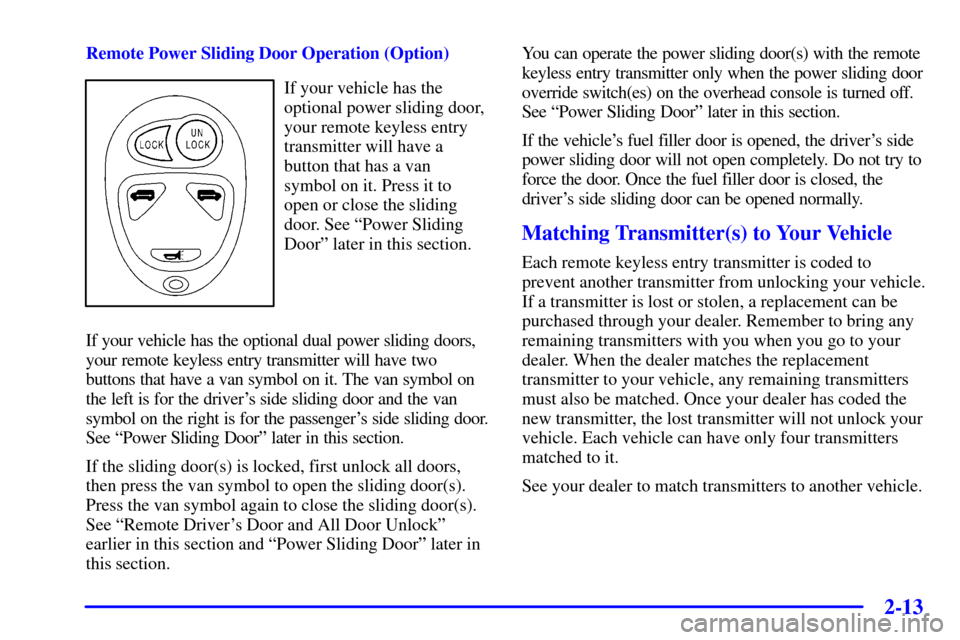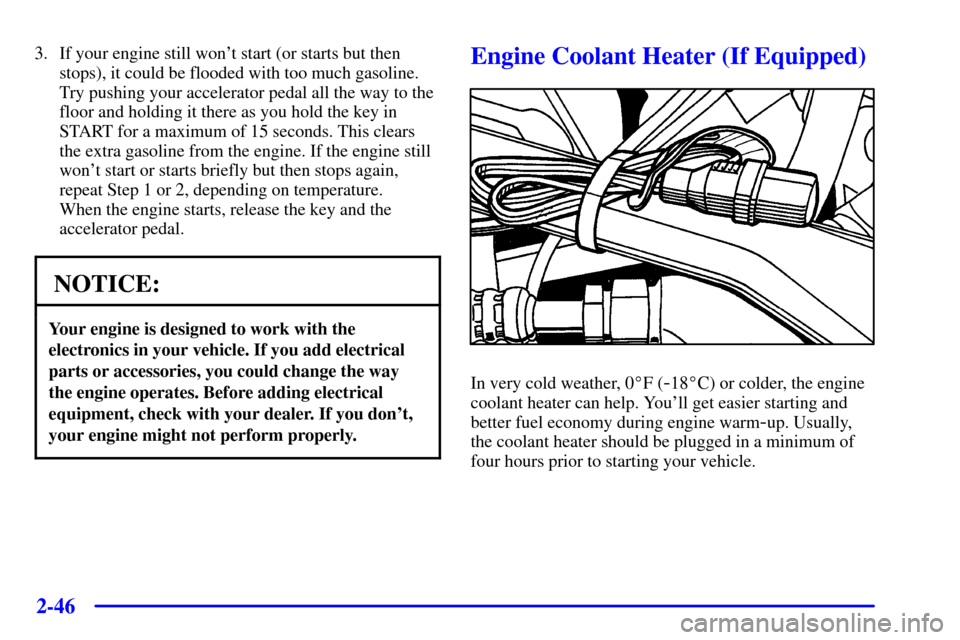Page 6 of 460
Table of Contents (cont'd)
Maintenance Schedule Service and Appearance Care
Section
7
Section
6
Scheduled Maintenance
Owner Checks and Services
Periodic Maintenance InspectionsRecommended Fluids and Lubricants
Maintenance Records Fuel
Checking Fluids and Lubricants
GM Oil Life System™
Engine Air Cleaner/Filter
Passenger Compartment Air Filter
Brakes
Bulb ReplacementWindshield Wiper Blade Replacement
Tires and Wheels
Appearance Care
Electrical System/Fuses and Circuit Breakers
Capacities and Specifications
Normal Maintenance Replacement Parts
iv
Page 11 of 460

ix
For example,
these symbols
are used on an
original battery:
CAUTION
POSSIBLE
INJURY
PROTECT
EYES BY
SHIELDING
CAUSTIC
BATTERY
ACID COULD
CAUSE
BURNS
AVOID
SPARKS OR
FLAMES
SPARK OR
FLAME
COULD
EXPLODE
BATTERY
These symbols
are important for
you and your
passengers
whenever your
vehicle is driven:
CHILD
RESTRAINT
TOP STRAP
ANCHOR
DOOR LOCK
UNLOCK
FASTEN
SEAT
BELTS
POWER
WINDOW
AIR BAG
These symbols
have to do with
your lamps:
MASTER
LIGHTING
SWITCH
TURN
SIGNALS
PARKING
LAMPS
HAZARD
WARNING
FLASHER
DAYTIME
RUNNING
LAMPS
FOG LAMPS
These symbols
are on some of
your controls:
WINDSHIELD
WIPER
WINDSHIELD
WASHER
WINDSHIELD
DEFROSTER
REAR
WINDOW
DEFOGGER
VENTILATING
FAN
These symbols
are used on
warning and
indicator lights:
ENGINE
COOLANT
TEMP
BATTERY
CHARGING
SYSTEM
BRAKE
COOLANT
ENGINE OIL
PRESSURE
ANTI-LOCK
BRAKES
Here are some
other symbols
you may see:
FUSE
LIGHTER
HORN
FUEL
Vehicle Symbols
These are some of the symbols you may find on your vehicle. Also see ªWarning Lights and Gagesº in the Index.
Page 12 of 460
Service Station Guide
For
a More
Detailed Look at
What's Under the Hood
See Section 6
Battery
See Section 6
Windshield Washer
Fluid
See Section 6
Tire Pressure
See Section 6
Spare Tire Pressure
See Section 5
Hood Release
See Section 6Cooling System
See Section 5
Secondary
Hood Release
See Section 6Oil Viscosity
Engine Oil
See Section 6
Engine Oil Dipstick
See Section 6
Fuel
Use unleaded only.
See Section 6
for octane ratings.
Page 126 of 460

2-13
Remote Power Sliding Door Operation (Option)
If your vehicle has the
optional power sliding door,
your remote keyless entry
transmitter will have a
button that has a van
symbol on it. Press it to
open or close the sliding
door. See ªPower Sliding
Doorº later in this section.
If your vehicle has the optional dual power sliding doors,
your remote keyless entry transmitter will have two
buttons that have a van symbol on it. The van symbol on
the left is for the driver's side sliding door and the van
symbol on the right is for the passenger's side sliding door.
See ªPower Sliding Doorº later in this section.
If the sliding door(s) is locked, first unlock all doors,
then press the van symbol to open the sliding door(s).
Press the van symbol again to close the sliding door(s).
See ªRemote Driver's Door and All Door Unlockº
earlier in this section and ªPower Sliding Doorº later in
this section.You can operate the power sliding door(s) with the remote
keyless entry transmitter only when the power sliding door
override switch(es) on the overhead console is turned off.
See ªPower Sliding Doorº later in this section.
If the vehicle's fuel filler door is opened, the driver's side
power sliding door will not open completely. Do not try to
force the door. Once the fuel filler door is closed, the
driver's side sliding door can be opened normally.
Matching Transmitter(s) to Your Vehicle
Each remote keyless entry transmitter is coded to
prevent another transmitter from unlocking your vehicle.
If a transmitter is lost or stolen, a replacement can be
purchased through your dealer. Remember to bring any
remaining transmitters with you when you go to your
dealer. When the dealer matches the replacement
transmitter to your vehicle, any remaining transmitters
must also be matched. Once your dealer has coded the
new transmitter, the lost transmitter will not unlock your
vehicle. Each vehicle can have only four transmitters
matched to it.
See your dealer to match transmitters to another vehicle.
Page 139 of 460

2-26
4. Count the number of chimes you hear. The number of
chimes indicates the vehicle's current programmed
mode. (If you do not wish to change the current mode,
you can either exit the programming mode by
following the instructions later in this section or
program the next feature available on your vehicle.)
5. Press the horn symbol to change the current mode.
6. Press the horn symbol until you hear the number of
chimes corresponding to the mode selection you want.
7. Remove your key from the door key cylinder.
The mode you selected is now set. You can either exit
the programming mode by following the instructions
next in this section or program the next feature available
on your vehicle.
Exiting Programming Mode
To exit programming mode, turn the key from
ACCESSORY to OFF and put fuse 47 back into the
instrument panel fuse block.
After programming a feature, you can exit the
programming mode at anytime. Also, if your vehicle is
equipped with the content
-theft deterrent system,
remember to arm the system before exiting.
Dual Sliding Doors
To open either sliding door from outside the vehicle,
pull the handle out and then pull the door toward the
rear. If you slide the door all the way back, the door will
rest in a detent position. The door must overcome this
detent when closing.
To move the door forward, you must first pull the door
past the open detent position.
The driver's side sliding door is designed to open only a
little if the fuel door is open. If this ever happens, don't
try to force the sliding door. Just close the driver's side
sliding door. Then when the fuel filler door is closed, the
driver's side sliding door can be opened normally.
Page 145 of 460
2-32
The driver's side sliding door is designed to open only a
little if the fuel door is open. If this ever happens, don't
try to force the sliding door. Just close the driver's side
sliding door. Then when the fuel filler door is closed, the
driver's side sliding door can be opened normally.
CAUTION:
You or others could be injured if caught in the
path of the sliding door. Make sure the door path
is clear before closing the door.
If you want to open the power sliding door(s) when the
override switch(es) is turned off, pull the inside or
outside handle and let go. The door will open fully.
To open the power sliding door(s) when the override
switch(es) is on, pull the inside or outside handle and
slide the door all the way back.
Page 154 of 460

2-41
PASS-Key� III
Your vehicle is equipped
with the PASS
-Key III
(Personalized Automotive
Security System)
theft
-deterrent system.
PASS
-Key III is a passive
theft
-deterrent system. This
means you don't have to do
anything different to arm or
disarm the system. It works
when you insert or remove
the key from the ignition.
Your PASS
-Key III system operates on a radio
frequency subject to Federal Communications
Commission (FCC) Rules and with Industry Canada.
This device complies with Part 15 of the FCC Rules.
Operation is subject to the following two conditions:
(1) this device may not cause harmful interference, and
(2) this device must accept any interference received,
including interference that may cause undesired operation.This device complies with RSS
-210 of Industry Canada.
Operation is subject to the following two conditions: (1) this
device may not cause interference, and (2) this device must
accept any interference received, including interference that
may cause undesired operation of the device.
Changes or modifications to this system by other than an
authorized service facility could void authorization to
use this equipment.
PASS
-Key III uses a radio frequency transponder in the
key that matches a decoder in your vehicle.
When the PASS
-Key III system senses that someone is
using the wrong key, it shuts down the vehicle's starter
and fuel systems. The starter will not work and fuel will
stop being delivered to the engine. Anyone using a
trial
-and-error method to start the vehicle will be
discouraged because of the high number of electrical
key codes.
If the engine does not start and the security message
comes on, the key may have a damaged transponder.
Turn the ignition off and try again.
Page 159 of 460

2-46
3. If your engine still won't start (or starts but then
stops), it could be flooded with too much gasoline.
Try pushing your accelerator pedal all the way to the
floor and holding it there as you hold the key in
START for a maximum of 15 seconds. This clears
the extra gasoline from the engine. If the engine still
won't start or starts briefly but then stops again,
repeat Step 1 or 2, depending on temperature.
When the engine starts, release the key and the
accelerator pedal.
NOTICE:
Your engine is designed to work with the
electronics in your vehicle. If you add electrical
parts or accessories, you could change the way
the engine operates. Before adding electrical
equipment, check with your dealer. If you don't,
your engine might not perform properly.
Engine Coolant Heater (If Equipped)
In very cold weather, 0�F (-18�C) or colder, the engine
coolant heater can help. You'll get easier starting and
better fuel economy during engine warm
-up. Usually,
the coolant heater should be plugged in a minimum of
four hours prior to starting your vehicle.